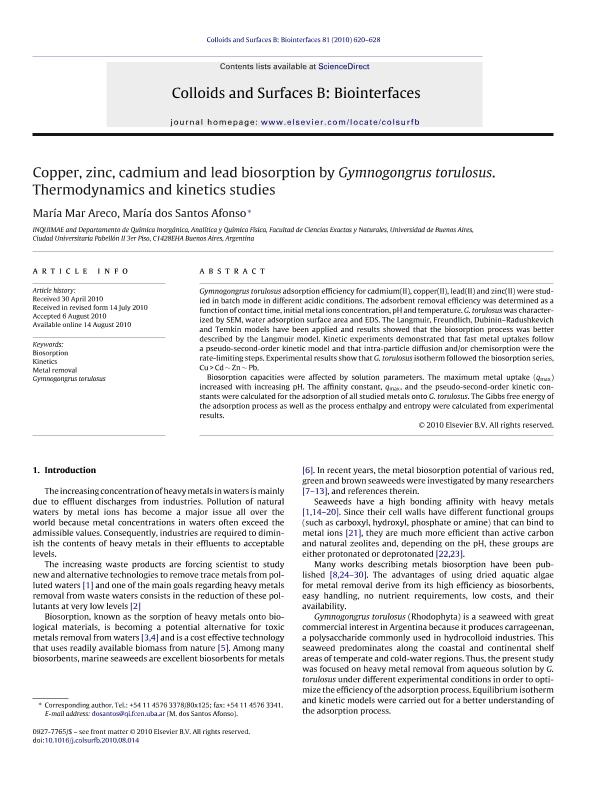Artículo
Copper, zinc, cadmium and lead biosorption by Gymnogongrus torulosus. Thermodynamics and kinetics studies
Fecha de publicación:
12/2010
Editorial:
Elsevier Science
Revista:
Colloids and Surfaces B: Biointerfaces
ISSN:
0927-7765
Idioma:
Inglés
Tipo de recurso:
Artículo publicado
Clasificación temática:
Resumen
Gymnogongrus torulosus adsorption efficiency for cadmium(II), copper(II), lead(II) and zinc(II) were studied in batch mode in different acidic conditions. The adsorbent removal efficiency was determined as a function of contact time, initial metal ions concentration, pH and temperature. G. torulosus was characterized by SEM, water adsorption surface area and EDS. The Langmuir, Freundlich, Dubinin-Radushkevich and Temkin models have been applied and results showed that the biosorption process was better described by the Langmuir model. Kinetic experiments demonstrated that fast metal uptakes follow a pseudo-second-order kinetic model and that intra-particle diffusion and/or chemisorption were the rate-limiting steps. Experimental results show that G. torulosus isotherm followed the biosorption series, Cu > Cd ∼ Zn ∼ Pb. Biosorption capacities were affected by solution parameters. The maximum metal uptake (qmax) increased with increasing pH. The affinity constant, qmax, and the pseudo-second-order kinetic constants were calculated for the adsorption of all studied metals onto G. torulosus. The Gibbs free energy of the adsorption process as well as the process enthalpy and entropy were calculated from experimental results.
Palabras clave:
BIOSORPTION
,
GYMNOGONGRUS TORULOSUS
,
KINETICS
,
METAL REMOVAL
Archivos asociados
Licencia
Identificadores
Colecciones
Articulos(SEDE CENTRAL)
Articulos de SEDE CENTRAL
Articulos de SEDE CENTRAL
Citación
Areco, María del Mar; Dos Santos Afonso, María; Copper, zinc, cadmium and lead biosorption by Gymnogongrus torulosus. Thermodynamics and kinetics studies; Elsevier Science; Colloids and Surfaces B: Biointerfaces; 81; 2; 12-2010; 620-628
Compartir
Altmétricas




